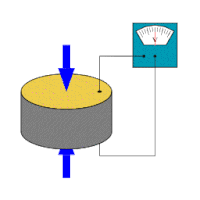
Photo from wikipedia
Achieving highly accurate responses to external stimuli during human motion is a considerable challenge for wearable devices. The present study leverages the intrinsically high surface-to-volume ratio as well as the… Click to show full abstract
Achieving highly accurate responses to external stimuli during human motion is a considerable challenge for wearable devices. The present study leverages the intrinsically high surface-to-volume ratio as well as the mechanical robustness of nanostructures for obtaining highly-sensitive detection of motion. To do so, highly-aligned nanowires covering a large area were prepared by capillarity-based mechanism. The nanowires exhibit a strain sensor with excellent gauge factor (≈35.8), capable of high responses to various subtle external stimuli (≤200 µm deformation). The wearable strain sensor exhibits also a rapid response rate (≈230 ms), mechanical stability (1000 cycles) and reproducibility, low hysteresis (<8.1%), and low power consumption (<35 µW). Moreover, it achieves a gauge factor almost five times that of microwire-based sensors. The nanowire-based strain sensor can be used to monitor and discriminate subtle movements of fingers, wrist, and throat swallowing accurately, enabling such movements to be integrated further into a miniaturized analyzer to create a wearable motion monitoring system for mobile healthcare.
Journal Title: Small
Year Published: 2020
Link to full text (if available)
Share on Social Media: Sign Up to like & get
recommendations!